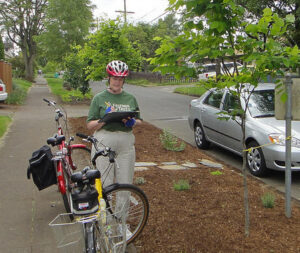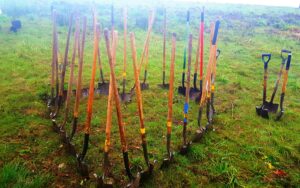Tag: Blueprint Foundation
Trees Through The Years
Our inspection program connects volunteers to specific trees, visit after visit.
When Friends of Trees plants a tree, we don’t just wash the dirt off of our hands and move onto the next one. We return to inspect it, to prune it, replenish mulch, and make sure everything is looking good. These check-ups are for more than just to care for that individual tree—we’re also collecting data.
Most of the data that we track is for younger trees, Tiers 1, 2, and 3, according to their age, Tier 1 being trees that were planted in the most recent season. We do this to make sure each tree was planted properly, to track the survival rates of different species, assess the quality of the nursery stock, and keep an eye out for any trends we need to adapt to.
“We also do this to provide tree care advice to the tree recipient,” Haley says. If a tree fails for reasons beyond neglect, we can replace the tree or refund the recipient.
There’s another set of much older trees that we have been collecting data on: Tier Omega. Tier Omega trees were planted in the 2010 season, and we’ve been checking on a subset of them, the same exact subset, every year since they were planted. This has created a consistent and robust data set that can show the long term survival rates of older plantings.
In the summer of 2010, 486 Tier Omega trees were planted. Since then, just 45 trees from the Tier Omega subset have died or were moved due to development reasons. Now that these trees have settled, they’re less likely to be dramatically impacted by weather, so we have been seeing fewer dead trees with each round of inspections.
“There’s this great community feel to it,” Neighborhood Trees Senior Specialist Haley Miller says about the inspection program. “We have some Tier Omega inspectors who have been inspecting the same exact trees for eleven years now.”
Mike Ablutz is one of those Tier Omega inspectors who just keeps coming back. “Revisiting the same trees over several years is like checking in with young friends,” he says. “I love seeing how they are doing, how fast they are growing, and discovering the many ways that they are adapting to life’s challenges.”
When people sign up to get a tree from Friends of Trees, they can volunteer to be tree inspectors. They are assigned a Tier 1 route of about twenty trees, including their own, that need to be inspected twice each summer. Inspectors monitor things like weeds, mulch, and water. They measure the size of the tree and look for things like bark damage. “It’s a popular volunteer role,” Haley says. “People really enjoy visiting their trees.”

The tree inspection process is also one of the ways we engage our youth education programming at Friends of Trees. Our partnerships with the Portland Opportunities Industrialization Center and the Blueprint Foundation connect students and young people to urban forestry work. In the summer, they get to help with tree inspection, which continues to develop forestry skills like tree identification, and grow their connections to nature.
We are learning more and more that when a person feels a connection to a particular tree, it grows their connection to trees and nature more broadly. Our tree inspectors are proof of that.
“I often imagine how the young trees we plant will look when they are old,” Mike says. “Tier Omega inspections allow me to revisit specific trees and at least see how they are doing in their early years.” Hopefully Mike will get the chance to keep revisiting those trees for years to come.
Support our community partners

If you viewed any of our Earth Month events (here’s the playlist) you probably noticed that we often talk about partnerships and climate justice. Friends of Trees’ community includes partnerships with a number of truly impactful local organizations that work with underserved communities. Underserved communities experience the worst effects of climate change and our partnerships that help connect communities to the benefits of trees play an important role in achieving climate justice.
We have a special request of you: Support our community partners. Yes, Friends of Trees will always need you, but if we are going to achieve true climate justice we all need to support Black, Indigenous or People of Color (BIPOC) organizations that are part of the movement to ensure equitable outcomes around trees and the urban canopy.
These organizations are Friends of Trees’ partners and need your support:
Asian Pacific American Network of Oregon (APANO): Uniting Asians and Pacific Islanders to achieve social justice.
The Blueprint Foundation: Uplift, educate, and support the development of black-identified youth and other communities of color.
Portland Opportunities Industrialization Center (POIC): Committed to the success of underserved youth and adults.
Wisdom of the Elders: Native American cultural sustainability, multimedia education and race reconciliation.
If you’d like to learn more about how Friends of Trees partners with these organizations visit our website here.
Thank you for supporting our work and the work of our partners, and for being a part of the Friends of Trees community.

